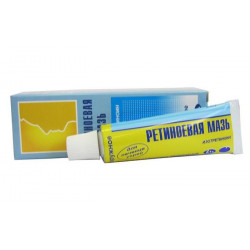



 All payments are encrypted via SSL
All payments are encrypted via SSL
 Full Refund if you haven't received your order
Full Refund if you haven't received your order
Retinoic ointment
Ointment.
In tubes of 15 g; in a pack of cardboard 1 tube.
Retinoic ointment has a dermatoprotective, antiseborrheic, keratolytic, anti-inflammatory effect. Retinoic acid is a biologically active form of vitamin A, is involved in the regulation of cell differentiation.
Acne ordinary, seborrheic dermatitis, rosacea, perioral dermatitis.
It is not recommended to apply to large areas of skin during pregnancy, breastfeeding and women planning pregnancy. It should not be prescribed to patients receiving other drugs from the group of retinoids. With care - in chronic diseases of the liver, kidneys, chronic pancreatitis, cardiac decompensation.
At 1-2 weeks of treatment, an exacerbation reaction is possible - the appearance of new rashes, itching, swelling and redness of the skin.
In case of a pronounced reaction, it is recommended to cancel treatment for several days before it subsides, then therapy can be resumed.
Isotretinoin (13-cis-retinoic acid) 0.1 g
Dibunol; butyloxyanisole; emulsion wax; vaseline oil; glycerol; ethyl alcohol 95%; purified water - up to 100 g
Used externally.For acne and rosacea, apply a thin layer to the affected skin 2 times a day. The duration of treatment is 4-12 weeks. A second course is possible after consulting a doctor.
Passing redness of the skin, new rashes from the 2nd week of treatment that do not require discontinuation of the drug. Sometimes - individual intolerance. Possible (with prolonged use) - cheilitis, conjunctivitis, dry and flaky skin.
The effect of the ointment is weakened with the simultaneous administration of antibiotics of the Tetracycline group, as well as topical administration of glucocorticosteroids.
Store at 2-8 ° C (do not freeze).
